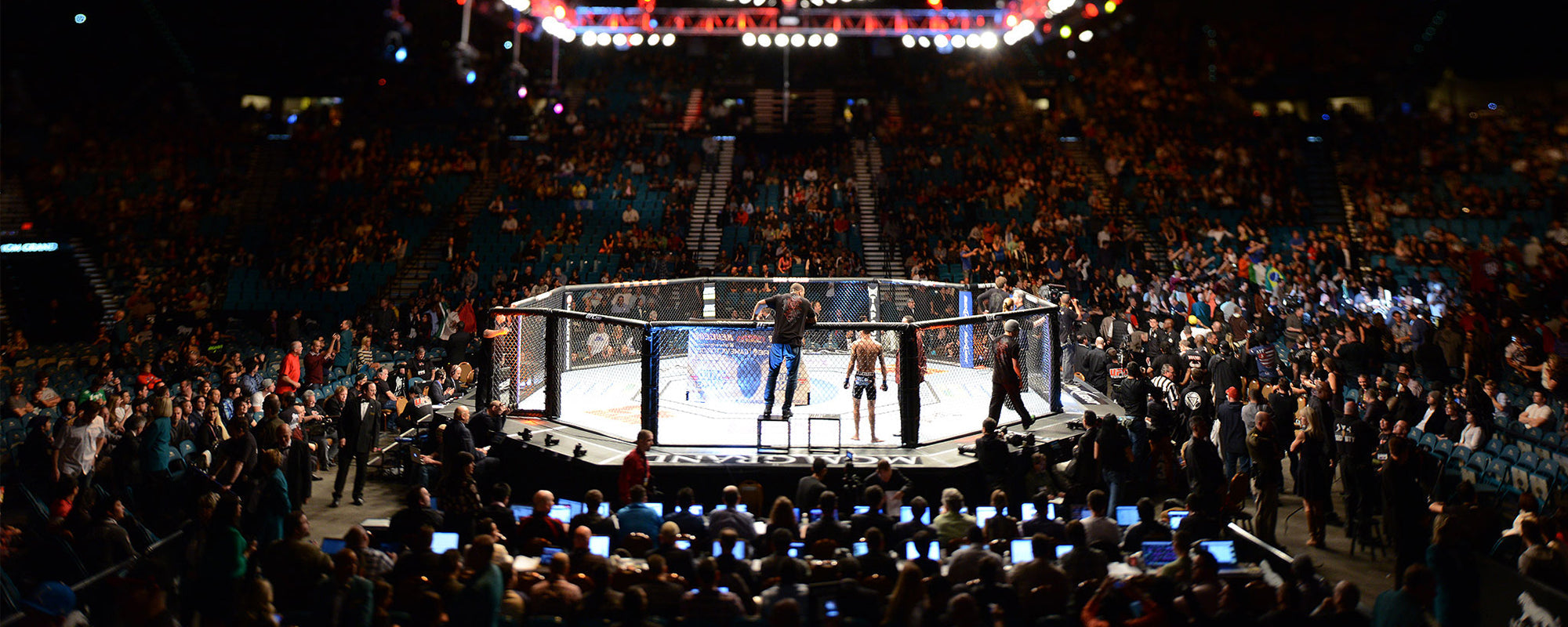Are you the one who wanted to know about the UFC scoring criteria? Most UFC fans are unaware of the UFC scoring system; they need to know on what basis UFC judges make the decisions on the fight nights. In this article, you will probe into the matter and discover the UFC system.
Table of content
1. UFC Scoring System

The Ultimate Fighting Championship (UFC) has a predefined scoring system. All the UFC fights are evaluated by the judges, who are three in number. The fighters are judged according to the criteria of the 10-point system. The judges can also give 10 points to each contender if both of them perform well; in this way, the match will result in a draw.
The UFC fighters are judged on their overall performance in the octagon. The contenders show their performance in several rounds, and if they can not knock out or submit to each other, the judges will decide.
Some illegal moves are banned inside the podium. If fighters use illegal strikes, their marks will be reduced, depending on the method they used and how much damage it caused to the competitor.
1.1. The Score of the UFC Rounds
UFC fights are based on three or five rounds, with each round lasting five minutes. Events like pay-per-view or fight night are based on five-round systems. These extra two rounds increase the curiosity of the spectators and intensify the performance of the UFC fighter.
The title fight as a whole lasts 29 minutes. It is also possible that the fight might end soon, as the fighters have achieved the fastest finishes with the submission or knockout method.
According to the 10-point system, the winner of each round will get 10 points, and the loser will score 9 or less. Each round is scored separately, and at the end of the bout, the scores of the three judges are compared to announce the winner.
2. UFC Fights Judging System
These judges probe into the octagon and give the scores according to the 10-point system. This standard has been set by the Unified Rules of Mixed Martial Arts (MMA). The UFC fight is based on the following criteria:
- Striking Capabilities
- Aggressiveness
- Cage Control
Striking Capabilities:
In the octagon, the fighter's performance is based on striking and grappling techniques. The judges measure the effectiveness of the grapplers by the impact of the strikes. The strikes are based on the impact of the successful landing of the submission techniques. The use of the correct methods and techniques creates the benefit in terms of striking.
The striking and grappling techniques include the use of takedowns with perfect timing. These tactics create effectiveness that also increases the fighters' points.
Aggressiveness:
The second criterion used for scoring is aggressiveness. If the judges give the same points to both competitors, then the points are given based on the fighter's passion and eagerness to end the bout. In this way, the UFC judges the fighter's performance based on the level of damage that the fighter causes.
Cage Control:
Cage control is the third stage on which the judges evaluate the fighters. It is based on the criteria of keeping the fighter pinned in place and maintaining control of the podium. Cage control shows the fighter's passion and capabilities in the arena.

2.1. How does the Judging System Work?
The judging system works on predefined strategies, which also evaluate the fighters based on visual facts, which are also based on the number of strikes. The judges evaluate each and every factor during a bout. They follow the number of strikes and their impact on their fellow fighters.
The fighters are also evaluated by their energy levels and how they control the opponent. If the fighter lands a high number of strikes on the competitor, then they will benefit from scoring points. Time management is also a significant factor in winning the bout.
2.2. Judge Score Cards

The scorecard, which includes the names of the judges and fighters, is given to each of the three judges. The middle section shows the number of rounds that might exceed the five rounds. The judges are distinguished by the colors white, blue, and yellow.
The judges can award points based on an athlete's performance described above. They might also have the authority to deduct the fighter's score. In the end, they subtract the sum of the points and compare the total scores with each other. The winner is declared after the discussion.
10 on 10 Score:
A fighter can get the maximum score of ten on ten in a scorecard. For that purpose, the fighter must be more proficient to attain a total score based on striking power and grappling skills, depict rage and aggressiveness, and maintain the dominant position in the octagon.
9 Score:
It is given to the fighter who has performed well on the podium. It is the most common mark obtained by the fighter who has landed perfect strikes and stayed dominant throughout the bout.
8 Score:
This is given to the fighter who has shown uncertainty in performance in terms of dominance and time taken to take control of the opponent.
7 Score:
It is the least common mark on which any fighter can be judged; it is given to fighters who remain unimpactful or show the least dominance during a bout.
After giving the scores and evaluating them through a discussion, the results are handed over to the cage announcer. The decision is based on the following criteria:
A unanimous decision or conclusion is taken after calculating the sum of the three judges. If every judge had given the highest score to fighter A, he would get points that might be 28 or 29. In this way, the fighter is announced a winner through a unanimous decision of UFC fighters.
The other way is to declare the winner by a Split Decision . As the name suggests, the decision has been made, but there is a difference between the judges' decisions. In this case, one of the judges has a slightly different decision than the other two judges.
The next decision is called the majority decision, which also depends on the decision of the two judges who have termed one fighter a winner and the third judge who has resulted in the fight being a draw. At that point, the decision of the majority is appreciated.
The technical decision is another term based on the fact that the bout ended before the time or one of the fighters received a penalty or foul during the match. At this stage, the judges decide who will win.
Bout Resulted in a Draw
It has been divided further into four main categories, which are as follows:
A majority Draw is considered when two judges have decided to draw the match, and one of the judges has declared one fighter the winner. In this scenario, the majority decision is made.
Technical Draw is applied when one of the fighters in the octagon gets injured and is unable to continue the fight due to a severe condition. In this way, the judges stop the match in between and end the bout with the decision of a technical draw.
Split draw is the scoring method in which all three judges make totally different decisions, but when the sum is taken out, it results in a draw.
The last criterion is the unanimous draw, in which the three judges make the same decision to draw the match.
2.3. The Decision of Referee
The referee plays a significant role in the octagon; he stays in the cage and looks closely at every aspect of the fight. The referee has the authority to deduct the scores of the fighter if they are using any illegal striking method during a fight.
The deduction of the points depends on the techniques used by the fighter. If the fighter has used the illegal move of kicking the head with the knee in the bending position, 2 points will be deducted from the scorecard.
The referee can deduct one point if the opponent has used the banned strikes or has been fouled. The referee can also give a warning, which can sometimes be followed by the deduction of one point.
2.4. Penalties and Fouls in UFC
The Ultimate Fighting Championship is based on some criteria that have rules and regulations that the fighters must follow. The referee gives fouls and penalties to the fighters, who are the rules brokers. This creates a very disrespectful impact on the fighters and may affect their physical capabilities.
If a fighter fails to obey the rules, it might lead to the deduction of the points, or they even get disqualified in a bout. The third penalty is to get a declaration of no contest. The fighter may face the consequences of a negative reputation or face multiple challenges in the professional field.
3. FAQs
3.1. What are the criteria for the winner of a UFC fight?
The UFC fighter needs to focus on the rules and regulations. Illegal strikes will result in a points deduction. The points are given based on the strikes and grappling skills of the fighter. The judges can give the scores based on the cage control and aggressiveness of the fighter.
3.2. How many rounds are there in UFC fights?
In UFC fights, there are typically three or five rounds, depending on the type of fight. The normal fight is based on the length of three rounds. The main events and the championship are five rounds.
Every round lasts five minutes, and the fighters can take a minute of break after each round.
3.3. On which criteria do UFC judges make the decision?
The decisions are made by the judges that is based on the following categories:
- Striking and grappling skills
- The aggressiveness of the fighter
- Octagon or cage control
3.4. Is it possible to draw the UFC fight?
Yes, the UFC fights can be considered a draw if the points of the fighters are the same. It has been divided further into four main categories, which are as follows:
- A Majority Draw
- Split Draw
- Unanimous draw
- Technical Draw
4. Final Words
A large number of spectators follow and like UFC fights, and now they are aware of the criteria by which the fighters get their scores. The most significant factors are the fighter's dominance, aggressiveness, and control inside the podium.
Judges mark the points on the scoresheet with a maximum of ten marks. After the bout, three judges take out the sum of the numbers to identify the winner. The judges give the scores after each round. The decision is made according to the professional criteria of the Ultimate Fighting Championship (UFC).









Leave a comment
This site is protected by hCaptcha and the hCaptcha Privacy Policy and Terms of Service apply.